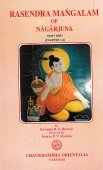Stable: 2 definitions
Introduction:
Stable means something in Hinduism, Sanskrit. If you want to know the exact meaning, history, etymology or English translation of this term then check out the descriptions on this page. Add your comment or reference to a book if you want to contribute to this summary article.
In Hinduism
Yoga (school of philosophy)
Source: ORA: Amanaska (king of all yogas): A Critical Edition and Annotated Translation by Jason BirchThe Stable (semen) is denoted by the Sanskrit term Sthairya, according to the Haṭhapradīpikā of Svātmārāma: an influential 15th-century Sanskrit manual on Hatha-Yoga dealing with techniques to channel one’s vital energy.—Accordingly, while discussing the retention of semen: “When there is steadiness of the mind, the breath is steady. Because of this, semen becomes stable (sthira). Because of the stability of semen, there is always strength [and so,] stability of the body arises”.

Yoga is originally considered a branch of Hindu philosophy (astika), but both ancient and modern Yoga combine the physical, mental and spiritual. Yoga teaches various physical techniques also known as āsanas (postures), used for various purposes (eg., meditation, contemplation, relaxation).
Pancaratra (worship of Nārāyaṇa)
Source: archive.org: Catalogue of Pancaratra Agama TextsThe Stable represents one of the various parts of a temple-compound (Prāsāda), as discussed in the fourteenth chapter of the Naradiyasamhita: a Pancaratra document comprising over 3000 verses in 30 chapters presenting in a narrative framework the teachings of Narada to Gautama, dealing primarily with modes of worship and festivals.—Description of the chapter [prāsādalakṣaṇa-vidhi]: [...] Nārada describes the various parts of a temple-compound—the dvāra-gates, the ardhamaṇḍapa, the mukhamaṇḍapa, the gala, the shrine for Garuḍa, placement of various other shrines in the āvaraṇa-courts, etc. He also describes the location of and appointments in the mahānasa-kitchen, where the store rooms, treasury, stable and wells are to be found, etc. [...]

Pancaratra (पाञ्चरात्र, pāñcarātra) represents a tradition of Hinduism where Narayana is revered and worshipped. Closeley related to Vaishnavism, the Pancaratra literature includes various Agamas and tantras incorporating many Vaishnava philosophies.
See also (Relevant definitions)
Query error!
Full-text (+449): Ashvashala, Mandura, Susthira, Hastishala, Tabela, Sthavara, Ashvagoshtha, Mandira, Vajishala, Kharashala, Dhruva, Sthayin, Manduraja, Sthira, Hayashala, Kharageha, Ashvakuti, Kharagriha, Sthiratman, Pragriva.
Relevant text
Search found 304 books and stories containing Stable; (plurals include: Stables). You can also click to the full overview containing English textual excerpts. Below are direct links for the most relevant articles:
Matangalila and Hastyayurveda (study) (by Chandrima Das)
Care and keeping of elephants < [Chapter 3]
Techniques of building Elephant abodes < [Chapter 3]
Megasthenes’ account on Elephants < [Chapter 3]
Samarangana-sutradhara (Summary) (by D. N. Shukla)
Chapter 30 - The Stables for the Horses (Aśvaśāla)
Chapter 29 - Stables for Elephants (Gajaśālā)
Chapter 44 - The effects of the Door break (Dvāra-bhaṅga-phala)
Kautilya Arthashastra (by R. Shamasastry)
Chapter 31 - The Superintendent of Elephants < [Book 2 - The duties of Government Superintendents]
Chapter 30 - The Superintendent of Horses < [Book 2 - The duties of Government Superintendents]
Chapter 4 - Buildings within the Fort < [Book 2 - The duties of Government Superintendents]
Kathasaritsagara (cultural study) (by S. W. Chitale)
The other sections and surroundings in the Palace < [Chapter 2 - Political conditions]
Description of the Army < [Chapter 2 - Political conditions]
Description of Warfare < [Chapter 2 - Political conditions]
Vinaya Pitaka (3): Khandhaka (by I. B. Horner)
The story of King Pajjota < [8. Robes (Cīvara)]
Eight wonderful things about the great ocean < [19. Suspending the Observance (Uposathaṭṭhāpana)]
The story of Dīghāvu < [10. The monks from Kosambī (Kosambaka)]
Vastu-shastra (Introduction to Indian architecture) (by D. N. Shukla)
Chapter 2b - Accessory Structures: Aśva-śālā (royal stable) < [Volume 4 - Palace Architecture]
Chapter 2c - Accessory Structures: Gaja-śālā (stables for elephants) < [Volume 4 - Palace Architecture]
Chapter 2 - Buildings in General < [Volume 3 - House Architecture]
Related products

